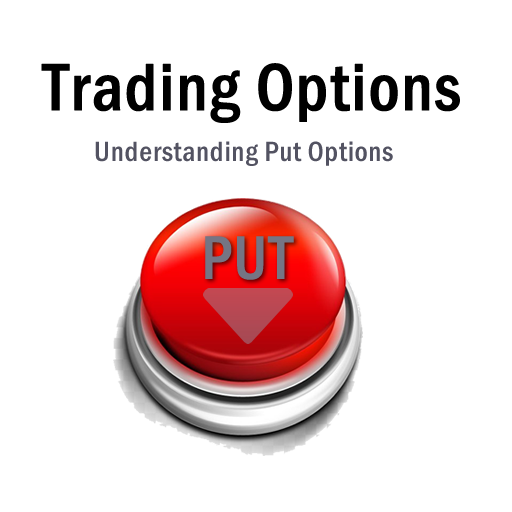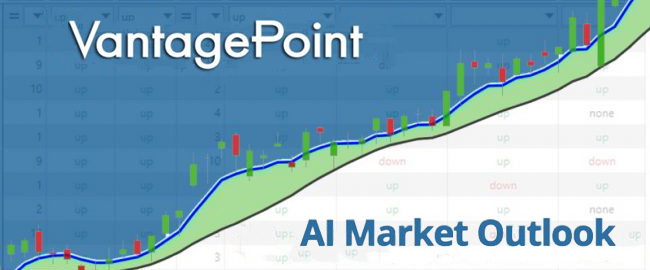A few weeks ago, in our article, “Yes Virginia There Is A Santa Claus Rally” we elaborated on a well-researched perspective from Yale Hirsh and The Stock Trader’s Almanac that favored the probability of a rally over the Christmas holiday and the beginning of the year. Mr. Hirsh and his research published that if the Santa Claus rally materialized but that if January ended up being a down month, it favored the probabilities of the entire year being a down year. Hirsch said: “If Santa Claus should fail to call, bears may come to Broad and Wall.” This refers to the exact location of where the New York Stock Exchange is located. Hirsch was naturally quipping that a failure for the Santa Claus rally to hold for January would often result in a bear market for the following year. Since we saw a down January in 2022 after a strong Santa Claus rally this is the perfect time to learn about put options.
In the distant past, there were not many ways a trader could monetize a falling market. Today we are going to continue in our discussion of understanding options. Specifically, we will focus on buying put options.
A put option is the right, but not the obligation, to sell the underlying stock at an agreed upon price between now and an expiration date, in exchange for a premium which is paid to the Put Option Seller (Creator).
There are a couple of important things to unpack so that you can clearly understand buying put options. The first is that if you are a buyer of the put option you have a right but not an obligation. Traders buy put options in anticipation of a price decline of the underlying asset. Put options trade on stocks, futures, forex, and cryptocurrencies so it will empower you to spend some time learning more about them.
The hardest thing for new traders to comprehend with regards to put options is the idea of selling the stock which they might not have previously owned. This concept challenges an initial understanding of how trading works. Traders who anticipate a price decline “borrow” an asset at its current price in anticipation of hopefully paying it back later at a lower price. If the price does move lower, they in essence sold high and bought low and created a corresponding profit. However, if the price moves higher after they have borrowed the stock, they sold high and bought back higher, it will have created a corresponding loss.
Markets move up and down, and there are profit opportunities which can be created to try and monetize these price swings. In the first part of this options trading series, I compared options buying to the insurance business. This is particularly valid when you are looking at purchasing a put option. Since the put option can only become more valuable based upon a price decline in the stock, put options are sometimes used by traders to hedge against losses. Meaning, a long-term stock investor will own the underlying stock and does not wish to sell it, instead they choose to purchase put options to hedge their risk against loss.
The simplest way to comprehend put options is to look at all of the components of a traditional put option order.
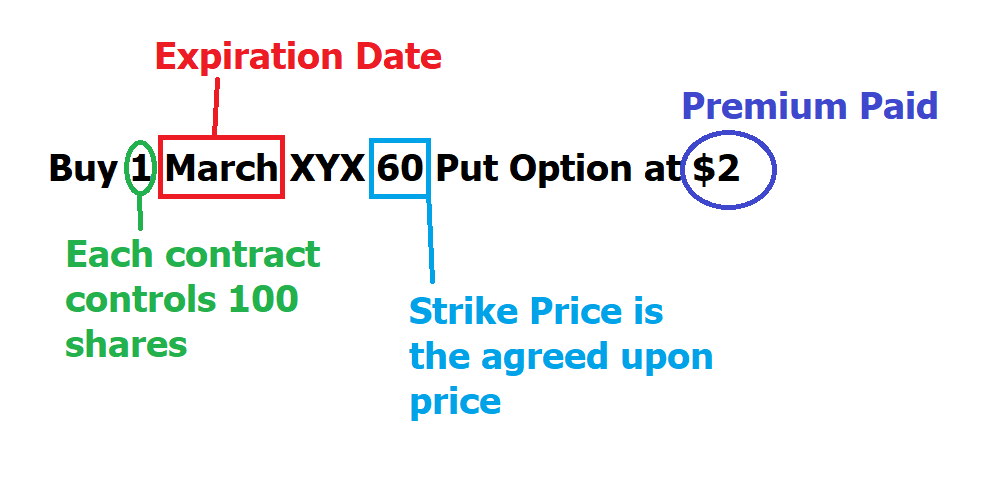
In the above example, the buyer is paying $2 per share or $200 for the right to sell XYX at $60 between now and the March Expiration date. Their risk is limited to the premium paid of $200. The contract will expire at the end of March.
Is this a good deal?
Well, that depends on where the underlying asset XYX is trading on the expiration date of March.
The option will expire worthless at the March expiration if the underlying asset is trading at any price $60 or over.
A couple of important points.
The breakeven point for a put option buyer will ALWAYS be the strike price of the option less the premium paid. So, in this instance, we have a strike price of $60 minus the $2 premium paid. This equates to $58 per share as the breakeven, at expiration where the option buyer can recover the $2.00 premium paid for the right to sell the stock at $60 per share.
Graphically this is represented as follows:
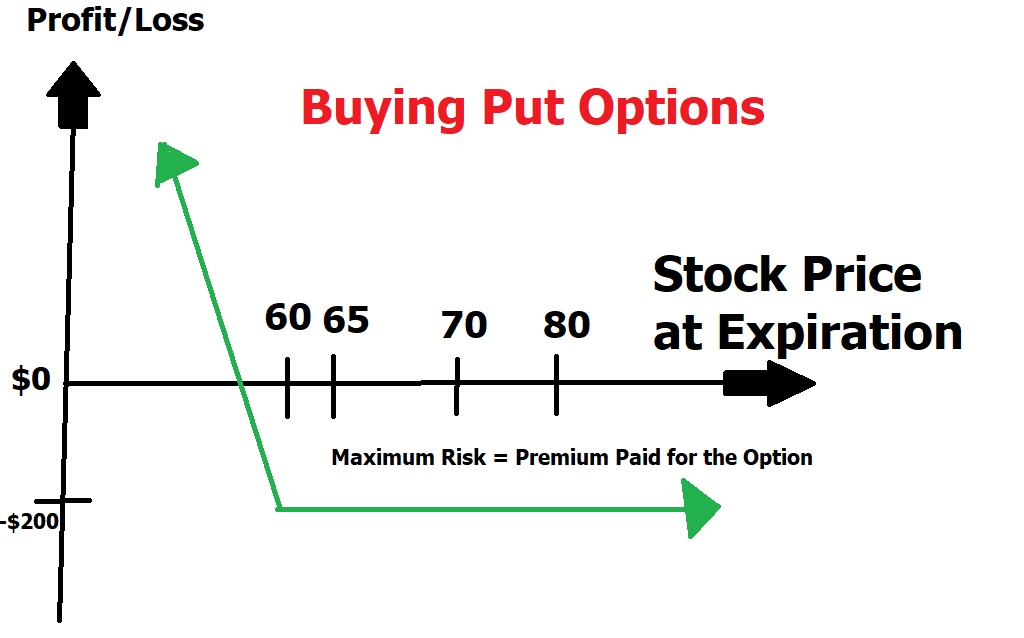
You can see that if the stock goes up in price the most the put option buyer can lose is the premium paid of $2.
Profits accrue exponentially at any price less than $58. What is the most money that this put option buyer can make?
Well, if the stock goes to zero, that means that put option buyer still has the right to sell the stock at $60 per share, so the option would be worth $60 per share less the premium of $2 paid, which equates to the option having an intrinsic value of $58.

Another way to illustrate this concept is to simply create a mini spreadsheet that shows what the value of the options would be at expiration looking at many strike prices. Here is a quick example of what the outcome would look like of BUY 1 March XYX 60 Put option at $2.
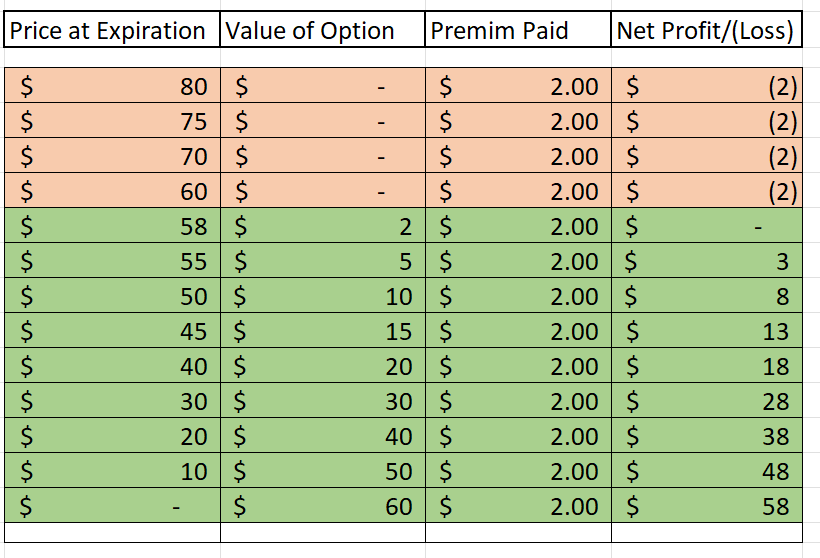
You can quickly see that the option expires worthless at any price over $60 per share at expiration. Should the stock drop precipitously you can quickly see that the option will accrue value very quickly at any price under $50 per share at expiration.
An option buyer controls 100 shares of stock for each contract that they purchase. When you understand this concept, you can also see how much leverage options trading has. To sell the underlying stock short at $60 per share, a trader would need $60 times 100 shares or $6,000. They can accomplish a similar objective in this regard by simply paying the option premium of $2 per share or $200 and purchasing the put option. This leverage is very attractive in luring traders in to learn more about option buying.
Trading options requires that the trader be correct on three levels, the underlying asset, the direction of the asset and the timing of the expiration date.
If a trader is incorrect on any of those, the probabilities do not favor that they will be successful in their option trade. However, on the flip side since the most they can lose is the option premium many traders often explore buying put options with a small part of their portfolio.
Options do not have to be held until expiration. They are very liquid instruments. Some traders trade options and only hold their contracts for a few hours. Others will hold them for many weeks. But the reality is that as an option buyer you decide how much risk you want to expose yourself to and for how long.
Lastly, what also is critical for put option buyers to understand is that options are deteriorating assets. Since they are time-sensitive and have an expiration date, we know in advance that all things being equal the option will be worth less tomorrow than today. In other words, the option premium is worth less and less the closer we get to the option expiration date. This is referred to as time decay or “theta.” The analogy of an insurance contract works well in this regard. An insurance policy with only 1 week left before it expires does not have a large value associated with it, even though it still offers its owners theoretical protection against loss.
Whenever you purchase options what you are purchasing is TIME. This amount of time is how options are priced. If the underlying asset is volatile the cost of TIME can be very expensive. If the asset is not volatile the cost of TIME is very cheap. The following graphic highlights the nature of options as a deteriorating asset. Meaning that the closer we get to the expiration date, the faster we see the decay in the options price.
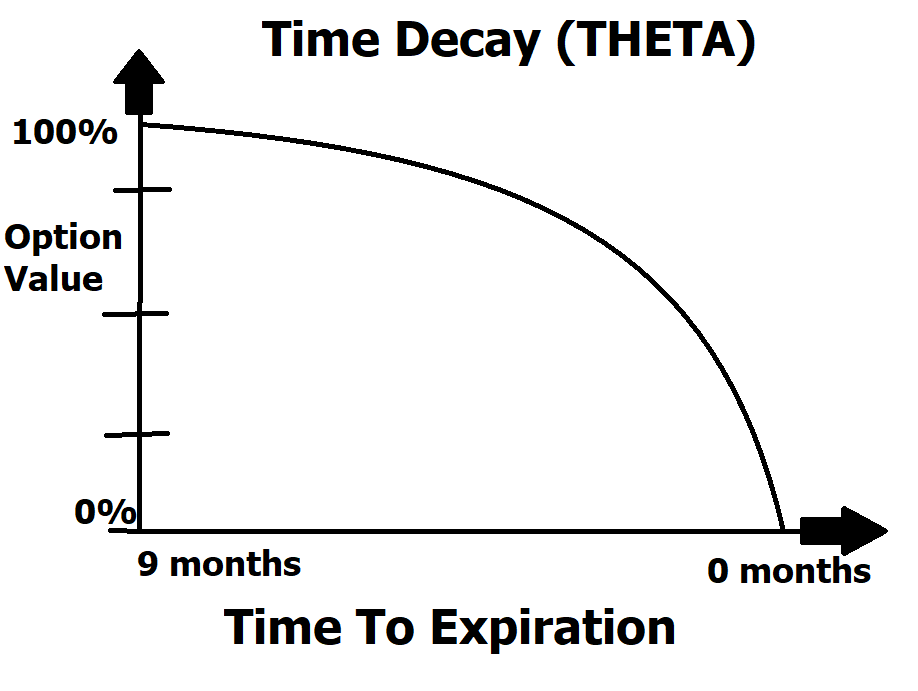
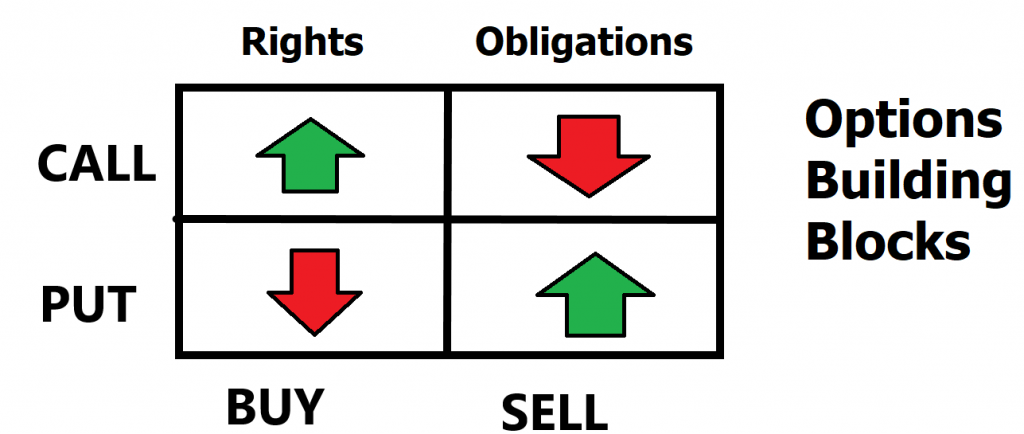
By thoroughly understanding each quadrant of the options building block process, it is possible to create strategies for income generation that put the probabilities overwhelmingly in the option traders’ favor. But to do this you need to have a very thorough understanding of each part of the option quadrant.
My suggestion is you spend some time studying each building block in this series. Why? Options typically cost much less than the underlying asset, but still offer exposure to the price movements of that asset without owning it. Mastering this arena is how professionals manage risk and create income with minimal risk in the marketplace. This occurs by learning to mix and match rights and obligations in a manner that is impossible to do with just the underlying asset.
In the interim, I’d like to invite you to attend our free Learn to Trade with A.I. Masterclass. On these trainings we teach traders how to artificial intelligence, neural networks and intermarket analysis can locate and isolate trading opportunities quickly and effectively. Often the best short-term opportunities with the greatest leverage can be found in the options market.
The Answer A.I. offers may surprise you.
This is how small traders grow their accounts by taking small bites out of the market consistently.
Today Artificial Intelligence, Machine Learning and Neural Networks are an absolute necessity in protecting your portfolio.
That is why artificial intelligence for traders is so indispensable.
Mistakes are financially costly but for machine learning, it is the pathway to mastery and excellence. The real education in trading always lies in learning from the losers.
Most humans have a really hard time learning from bad experiences. The ego gets in the way, every time.
Since artificial intelligence has beaten humans in Poker, Chess, Jeopardy and Go! do you really think trading is any different?
Knowledge. Useful knowledge. And its application is what A.I. delivers.
This is how Vantagepoint artificial intelligence simplifies and empowers traders daily!
Intrigued?
Discover why artificial intelligence is the solution professional traders go to for less risk, more rewards, and guaranteed peace of mind.
Visit With US and check out the a.i. at our Next Live Training.
It’s not magic. It’s machine learning.
Make it count.
THERE IS A SUBSTANTIAL RISK OF LOSS ASSOCIATED WITH TRADING. ONLY RISK CAPITAL SHOULD BE USED TO TRADE. TRADING STOCKS, FUTURES, OPTIONS, FOREX, AND ETFs IS NOT SUITABLE FOR EVERYONE.IMPORTANT NOTICE!
DISCLAIMER: STOCKS, FUTURES, OPTIONS, ETFs AND CURRENCY TRADING ALL HAVE LARGE POTENTIAL REWARDS, BUT THEY ALSO HAVE LARGE POTENTIAL RISK. YOU MUST BE AWARE OF THE RISKS AND BE WILLING TO ACCEPT THEM IN ORDER TO INVEST IN THESE MARKETS. DON’T TRADE WITH MONEY YOU CAN’T AFFORD TO LOSE. THIS ARTICLE AND WEBSITE IS NEITHER A SOLICITATION NOR AN OFFER TO BUY/SELL FUTURES, OPTIONS, STOCKS, OR CURRENCIES. NO REPRESENTATION IS BEING MADE THAT ANY ACCOUNT WILL OR IS LIKELY TO ACHIEVE PROFITS OR LOSSES SIMILAR TO THOSE DISCUSSED ON THIS ARTICLE OR WEBSITE. THE PAST PERFORMANCE OF ANY TRADING SYSTEM OR METHODOLOGY IS NOT NECESSARILY INDICATIVE OF FUTURE RESULTS. CFTC RULE 4.41 – HYPOTHETICAL OR SIMULATED PERFORMANCE RESULTS HAVE CERTAIN LIMITATIONS. UNLIKE AN ACTUAL PERFORMANCE RECORD, SIMULATED RESULTS DO NOT REPRESENT ACTUAL TRADING. ALSO, SINCE THE TRADES HAVE NOT BEEN EXECUTED, THE RESULTS MAY HAVE UNDER-OR-OVER COMPENSATED FOR THE IMPACT, IF ANY, OF CERTAIN MARKET FACTORS, SUCH AS LACK OF LIQUIDITY. SIMULATED TRADING PROGRAMS IN GENERAL ARE ALSO SUBJECT TO THE FACT THAT THEY ARE DESIGNED WITH THE BENEFIT OF HINDSIGHT. NO REPRESENTATION IS BEING MADE THAT ANY ACCOUNT WILL OR IS LIKELY TO ACHIEVE PROFIT OR LOSSES SIMILAR TO THOSE SHOWN.





